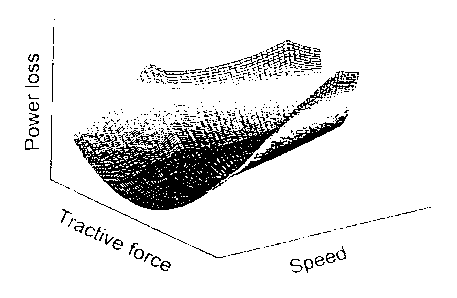Une partie des informations de ce site Web a été fournie par des sources externes. Le gouvernement du Canada n'assume aucune responsabilité concernant la précision, l'actualité ou la fiabilité des informations fournies par les sources externes. Les utilisateurs qui désirent employer cette information devraient consulter directement la source des informations. Le contenu fourni par les sources externes n'est pas assujetti aux exigences sur les langues officielles, la protection des renseignements personnels et l'accessibilité.
L'apparition de différences dans le texte et l'image des Revendications et de l'Abrégé dépend du moment auquel le document est publié. Les textes des Revendications et de l'Abrégé sont affichés :
| (12) Demande de brevet: | (11) CA 2379775 |
|---|---|
| (54) Titre français: | PROCEDE D'OPTIMISATION DE LA CONSOMMATION ENERGETIQUE POUR UN VEHICULE/TRAIN A RENDEMENT DEPENDANT DU POINT DE TRAVAIL |
| (54) Titre anglais: | METHOD FOR POWER OPTIMIZATION IN A VEHICLE/TRAIN HAVING AN EFFICIENCY THAT DEPENDS ON THE OPERATING POINT |
| Statut: | Réputée abandonnée et au-delà du délai pour le rétablissement - en attente de la réponse à l’avis de communication rejetée |
| (51) Classification internationale des brevets (CIB): |
|
|---|---|
| (72) Inventeurs : |
|
| (73) Titulaires : |
|
| (71) Demandeurs : |
|
| (74) Agent: | SMART & BIGGAR LP |
| (74) Co-agent: | |
| (45) Délivré: | |
| (86) Date de dépôt PCT: | 2000-07-26 |
| (87) Mise à la disponibilité du public: | 2001-02-08 |
| Licence disponible: | S.O. |
| Cédé au domaine public: | S.O. |
| (25) Langue des documents déposés: | Anglais |
| Traité de coopération en matière de brevets (PCT): | Oui |
|---|---|
| (86) Numéro de la demande PCT: | PCT/EP2000/007152 |
| (87) Numéro de publication internationale PCT: | WO 2001008959 |
| (85) Entrée nationale: | 2002-01-28 |
| (30) Données de priorité de la demande: | ||||||
|---|---|---|---|---|---|---|
|
Procédé d'optimisation énergétique pour un véhicule/train en cas d'utilisation des temps de réserve prévus par un tableau de marche. Pour parvenir à une manière de rouler économisant de l'énergie à l'aide d'un algorithme d'optimisation, on prend en considération la dépendance existant entre le point de travail et le rendement du véhicule ou la dissipation de puissance.
The invention relates to a method for optimizing the energy consumption of a
motor vehicle/train that uses time reserves provided for in a schedule. The
aim of the invention is to improve the operating characteristics of said motor
vehicle/train in such a manner that energy is saved by using an optimization
algorithm. To this end, the correlation between the vehicle efficiency or the
dissipated energy and the operating point is taken into consideration.
Note : Les revendications sont présentées dans la langue officielle dans laquelle elles ont été soumises.
Note : Les descriptions sont présentées dans la langue officielle dans laquelle elles ont été soumises.

2024-08-01 : Dans le cadre de la transition vers les Brevets de nouvelle génération (BNG), la base de données sur les brevets canadiens (BDBC) contient désormais un Historique d'événement plus détaillé, qui reproduit le Journal des événements de notre nouvelle solution interne.
Veuillez noter que les événements débutant par « Inactive : » se réfèrent à des événements qui ne sont plus utilisés dans notre nouvelle solution interne.
Pour une meilleure compréhension de l'état de la demande ou brevet qui figure sur cette page, la rubrique Mise en garde , et les descriptions de Brevet , Historique d'événement , Taxes périodiques et Historique des paiements devraient être consultées.
| Description | Date |
|---|---|
| Inactive : CIB de MCD | 2006-03-12 |
| Demande non rétablie avant l'échéance | 2005-07-26 |
| Le délai pour l'annulation est expiré | 2005-07-26 |
| Réputée abandonnée - omission de répondre à un avis sur les taxes pour le maintien en état | 2004-07-26 |
| Lettre envoyée | 2003-06-02 |
| Lettre envoyée | 2003-06-02 |
| Lettre envoyée | 2003-06-02 |
| Lettre envoyée | 2003-06-02 |
| Lettre envoyée | 2003-06-02 |
| Inactive : Transfert individuel | 2003-04-24 |
| Inactive : Lettre officielle | 2002-08-02 |
| Inactive : Page couverture publiée | 2002-07-24 |
| Inactive : Lettre de courtoisie - Preuve | 2002-07-23 |
| Inactive : Notice - Entrée phase nat. - Pas de RE | 2002-07-18 |
| Inactive : Demandeur supprimé | 2002-07-18 |
| Demande reçue - PCT | 2002-05-07 |
| Inactive : Correspondance - Transfert | 2002-03-01 |
| Inactive : Correspondance - Formalités | 2002-03-01 |
| Exigences pour l'entrée dans la phase nationale - jugée conforme | 2002-01-28 |
| Demande publiée (accessible au public) | 2001-02-08 |
| Date d'abandonnement | Raison | Date de rétablissement |
|---|---|---|
| 2004-07-26 |
Le dernier paiement a été reçu le 2003-06-25
Avis : Si le paiement en totalité n'a pas été reçu au plus tard à la date indiquée, une taxe supplémentaire peut être imposée, soit une des taxes suivantes :
Veuillez vous référer à la page web des taxes sur les brevets de l'OPIC pour voir tous les montants actuels des taxes.
| Type de taxes | Anniversaire | Échéance | Date payée |
|---|---|---|---|
| Taxe nationale de base - générale | 2002-01-28 | ||
| TM (demande, 2e anniv.) - générale | 02 | 2002-07-26 | 2002-07-19 |
| Enregistrement d'un document | 2003-04-24 | ||
| TM (demande, 3e anniv.) - générale | 03 | 2003-07-28 | 2003-06-25 |
Les titulaires actuels et antérieures au dossier sont affichés en ordre alphabétique.
| Titulaires actuels au dossier |
|---|
| BOMBARDIER TRANSPORTATION GMBH |
| Titulaires antérieures au dossier |
|---|
| CHRISTIAN KLOSE |
| KARL-HERMANN KETTELER |
| MARKUS MEYER |
| PETER TERWIESCH |
| RUDIGER FRANKE |